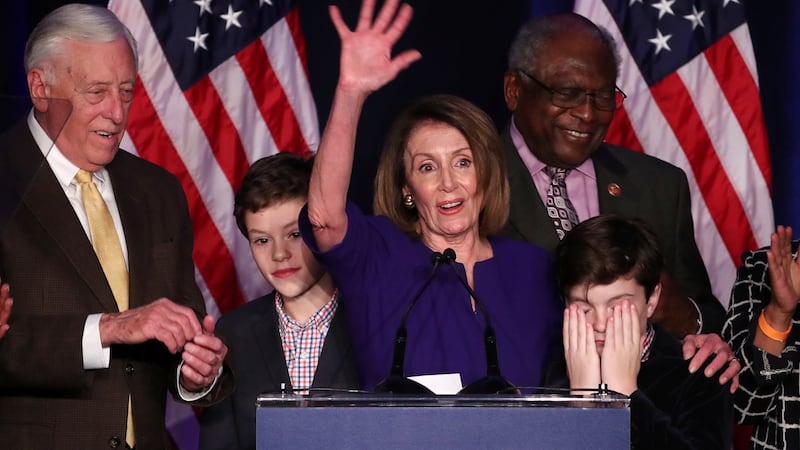For those looking for a decisive snapshot of the state of American politics in 2018, the results of the midterm elections are frustratingly inadequate.
Essentially two very different pictures emerged from Tuesday’s polls.
Democrats decisively wrested control of the House of Representatives from Republicans, and are on course to gain up to 35 seats. This is an impressive achievement for the party, even accounting for the fact that the minority party tends to do well in midterm elections.

But their performance in the Senate fell far short. While polls consistently showed that Democrats were facing an uphill battle to win control of the Senate, some had dared to hope that “toss-up states” could be within their grasp.
From Missouri to Texas to Tennessee, there had been a glimmer of hope that Democrats could catch a wave, that the mood of the country was such that they could beat the odds and pull off a tight victory. But in the end, this did not happen. Rather than simply maintain their 51-49 majority, Republicans will increase their Senate majority.
Within an hour of the first polls closing, it became apparent that a blue wave was not on the cards. Despite early pick-ups such as a Democrat victory in Virginia’s 10th congressional district, other toss-up seats did not go blue. Democrats failed to flip Kentucky’s sixth district, where former marine pilot Amy McGrath had a shot at unseating the incumbent Republican for example.
A similar pattern was evident in the crunch Senate seats, where Democratic candidates came close but not close enough. Beto O’Rourke put in a strong performance in Texas where he mounted a serious challenge to incumbent Ted Cruz, but ultimately was defeated. Similarly, hopes that popular governor Phil Bredesen could pull off a victory in Tennessee were thwarted.
Flipping of seats
There was much to applaud in the Democrats’ performance. The party flipped dozens of Republican seats across the country, including the all-important suburban districts. Women candidates outperformed. In Pennsylvania alone – a state with no women representatives in Congress currently – four women won House seats. Both these trends should worry Republicans ahead of the 2020 presidential election.
But Republicans will also be buoyed by their party’s performance.
Many in the country had hoped that the first full electoral verdict on the presidency of Donald Trump would deliver a decisive repudiation of Trumpism. The results do not bear this out.
As Trump’s press conference in the White House on Wednesday confirmed, the president feels vindicated by the results. In the run-up to the election he had been criticised by many, including members of his own party, for not focusing on the strong economy and instead highlighting immigration. The better-than-expected performance of Republicans may suggest that his strategy worked.
His combative tone on Wednesday suggested he is convinced that his decision to focus on the Senate and not the House in the election campaign proved he still has the political instincts that helped win him the White House in 2016. Ultimately the three states he visited on his last day of campaigning on Monday – Ohio, Indiana and Missouri – all delivered Republican victories.
The decisive victory of Democrats in the House, however, brings a new political reality to Washington and a new conundrum for Trump – an opposition House of Representatives.
Impeachment proceedings
Democrats will now have subpoena powers that could allow key committees to demand the president’s tax returns or details of his financial dealings with foreign powers.
A Democrat-controlled House will also decide whether to launch impeachment proceedings against the president once Robert Mueller reports, though impeachment needs a two-thirds majority in the Senate.
Much of the focus in Washington in the coming days will be on Nancy Pelosi’s leadership of the Democratic party. At 78 years of age, many wonder is Pelosi the face of change that Democrats need as they try to redefine themselves for the time ahead.
But the country is already turning its focus to 2020. The maths of the presidential election are very different to the maths of the midterm elections.
Trump’s unlikely victory in 2016 came about because he flipped a number of key swing states and “rustbelt” districts, albeit by a small margin.
Capturing the electoral college votes of those states is essential if the Democrats want a path to victory in 2020.
In this regard, the midterm elections present a mixed picture. Democrats performed well in three key midwestern states that Hillary Clinton lost in 2016 – Pennsylvania, Wisconsin and Michigan elected Democratic governors in all three states.
But Republicans won the governor race and various state seats in Ohio, while in Florida they were on course to win the tight Senate and gubernatorial races. Both these states will play a key role in the presidential election.
As Trump prepares for a new phase of his presidency, he appeared rejuvenated by the election results. His surprise praise for Pelosi prompted suspicions that he believes the Democratic House majority could actually aid him politically in 2020. As a combative president who thrives on division, the president may be happy to use the Democrat-controlled House as a foil, blaming Democrats for not allowing him to achieve many of his campaign promises.
That Democrats performed well within expectations but failed to deliver a knock-out blow against a candidate as unpopular as Trump should be cause for concern. For Trump, the better-than-expected performance in the Senate will be sufficient proof that Trumpism is alive and well and will be a potent force in the 2020 elections.
Suzanne Lynch is Washington correspondent










